I have yet to read details about Chipotle's plans to launch a quick-service Asian concept (perhaps because there aren't many), but I find this article interesting for how it characterizes and generalizes about Mexican and Chinese cuisine.
3 Challenges Chipotle Faces Launching an Asian Chain
I'm guessing that certain figures of Mexican cuisine, including Top Chef Master Rick Bayless, Diana Kennedy, and those who advocated for UNESCO to recognize Michoacan cuisine as a form of intangible cultural heritage might object to the idea that "Mexican food is pretty simple to execute. You throw together beans, tortillas, a few meats and cheeses, guacamole, rice, and you’re pretty set."
Oddly, she contrasts this to Asian food which "involves a lot more chef expertise, more ingredients, different spices, and more complex dishes that are tricky to keep appetizing-looking in a warming tray — just hit your local grocery store’s hot-deli line or a shopping-mall food court and take a look." Rick Bayless's preparation of mole negro for a recent state dinner at the White House included more than 20 different ingredients and took several days to prepare. That's just for the sauce.
Tice also thinks that quick-service Asian food based on local, organic ingredients faces a greater challenge compared to doing the same for Mexican food. But my guess is that Chipotle will choose those Asian dishes that serve their model well, rather than trying to represent the range or depth of Asian cuisine. Sidestepping the PC-minefield of conflating the diversity of Asian cuisines into one concept, I can see a Vietnamese "inspired" (for all you purists out there) menu that could easily work within the Chipotle model:
Banh mi sandwiches
Bun (room temp vermicelli salad-type dish)
Spring/summer/garden rolls (I'm thinking of the fresh ones, rather than the deep fried ones)
All of these draw upon easy to source local ingredients, can be adapted to suit a variety of diets and food preferences, and can be quickly assembled to order. Oh yes, and they're delicious.
You could even throw pho into the mix, though I would only recommend it for eat-in customers (and squeamish eaters probably wouldn't want the raw beef on the side). Takeaway pho is never a good idea...
Monday, December 6, 2010
Tuesday, November 23, 2010
Mexico
I've been horrible at updating this blog, and sadly, it's not because I've been eating delicious things instead. Then again, I suppose reading about delicious things (thank you Anthropology of French Food and Culinary Tourism courses!) isn't so bad either.
So, in honor of UNESCO's recent recognition of Mexican food and the Michoacan paradigm as products of intangible cultural heritage,* I take you back to a simpler time, when so much of my everyday experience was focused on food. Rewind five months to my five-week program in Oaxaca, Mexico, birthplace of chocolate and mole:
Posole
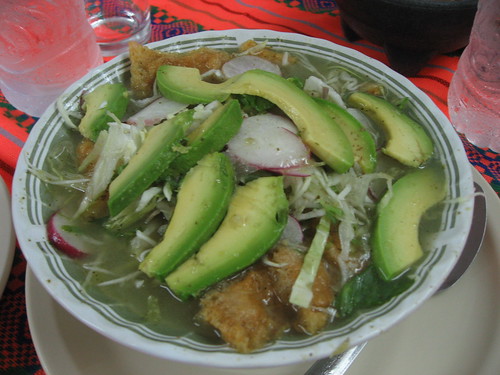
Ballpark hot dog, cheering on the minor league Oaxaca Guerreros

Street tacos in the Zocalo
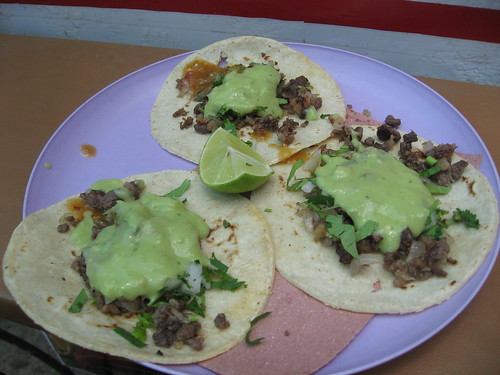
Amazing salsa at the women's weaving cooperative in Teotitlan del Valle

Nieves
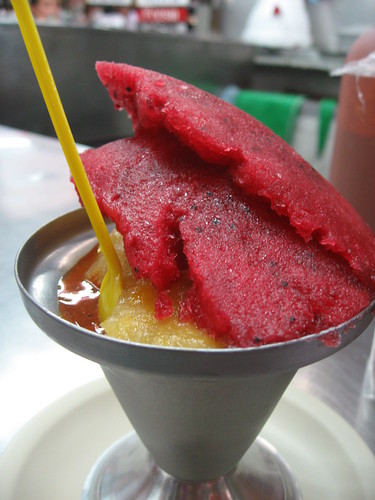
This is all that you'll see of the tacos al pastor. Because they were that delicious.
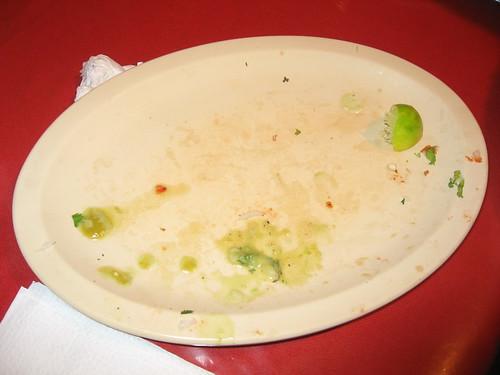
Hot chocolate
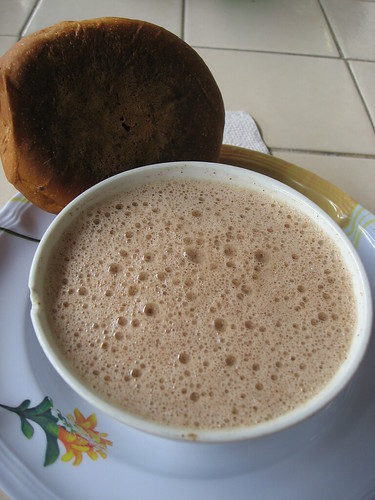
Mole coloradito, my favorite of the 7/1,000/7,000 moles of Oaxaca

And of course, the infamous chapulines (grasshoppers). Legend has it that eating chapulines assures that you will return to Oaxaca.

I guess I better start looking for plane tickets:

(photo courtesy of Laura)
*For a more nuanced take on whether this recognition is actually a good thing, see Is 'Culinary Heritage' a Good Idea?.
So, in honor of UNESCO's recent recognition of Mexican food and the Michoacan paradigm as products of intangible cultural heritage,* I take you back to a simpler time, when so much of my everyday experience was focused on food. Rewind five months to my five-week program in Oaxaca, Mexico, birthplace of chocolate and mole:
Posole

Ballpark hot dog, cheering on the minor league Oaxaca Guerreros

Street tacos in the Zocalo

Amazing salsa at the women's weaving cooperative in Teotitlan del Valle

Nieves

This is all that you'll see of the tacos al pastor. Because they were that delicious.

Hot chocolate

Mole coloradito, my favorite of the 7/1,000/7,000 moles of Oaxaca

And of course, the infamous chapulines (grasshoppers). Legend has it that eating chapulines assures that you will return to Oaxaca.

I guess I better start looking for plane tickets:

(photo courtesy of Laura)
*For a more nuanced take on whether this recognition is actually a good thing, see Is 'Culinary Heritage' a Good Idea?.
Wednesday, October 20, 2010
Why do you go to restaurants?
In a piece for SFGate's food coverage, Clark Wolf counters "Best Restaurant in the World" chef Rene Redzepi's contention that people go to restaurants only to refuel or to be challenged by listing the myriad other ways that restaurant dining affects him.
On the Purpose of Going to Restaurants
The range of emotions that Wolf describes echo my own attachments to food: "I delight, I remember, I grab comfort, I just smile. Food can make me giggle or get me teary, deeply satisfy or stimulate my desire for more. It can calm me the freak down or really rev me up." But it also speaks to the visceral power that food holds -- which is exactly what makes it a powerful tool for communication generally, and culinary diplomacy more specifically. The range of emotions that food can inspire speaks to the range of ways in which food can be mobilized to reinforce or counter a particular message.
Of course, it also speaks to the stakes in getting food right: "Food gone wrong (or professionally wronged) can get me crabby or leave me sad and empty – all while feeling full. It can confuse and upset, annoy or mildly amuse." Or just inspire uninhibited aggression:

Clark also balks at the constant need, mostly on the part of young male chefs, for food to be a challenge, and the fact that critics and gastronomes consistently associate bold, edgy, revolutionary with "best". To which I say, hear hear! As a visceral, and often times primal, experience, food should be about what it inspires within you, the eater, regardless of the preparation techniques involved. Obviously, surprise and innovation can be compelling. But there is also the risk of alienation that accompanies edgy, revolutionary food, which seems to undercut one of the primary purposes of eating (in my mind): to revel in one's food, to enjoy and savor and be satisfied. Food education, learning to understand and appreciate new foods, might be work, but food itself shouldn't be.
On the Purpose of Going to Restaurants
The range of emotions that Wolf describes echo my own attachments to food: "I delight, I remember, I grab comfort, I just smile. Food can make me giggle or get me teary, deeply satisfy or stimulate my desire for more. It can calm me the freak down or really rev me up." But it also speaks to the visceral power that food holds -- which is exactly what makes it a powerful tool for communication generally, and culinary diplomacy more specifically. The range of emotions that food can inspire speaks to the range of ways in which food can be mobilized to reinforce or counter a particular message.
Of course, it also speaks to the stakes in getting food right: "Food gone wrong (or professionally wronged) can get me crabby or leave me sad and empty – all while feeling full. It can confuse and upset, annoy or mildly amuse." Or just inspire uninhibited aggression:

Clark also balks at the constant need, mostly on the part of young male chefs, for food to be a challenge, and the fact that critics and gastronomes consistently associate bold, edgy, revolutionary with "best". To which I say, hear hear! As a visceral, and often times primal, experience, food should be about what it inspires within you, the eater, regardless of the preparation techniques involved. Obviously, surprise and innovation can be compelling. But there is also the risk of alienation that accompanies edgy, revolutionary food, which seems to undercut one of the primary purposes of eating (in my mind): to revel in one's food, to enjoy and savor and be satisfied. Food education, learning to understand and appreciate new foods, might be work, but food itself shouldn't be.
Monday, August 30, 2010
A regional food concept and international inspiration
I have much to catch up on, but for now, some interesting articles:
More than just eating local: Home Grown
Sean Brock is opening a restaurant in South Carolina called Husk, where the cuisine will be firmly rooted in the South: if it's not grown there, or if it's not historically related to the area, no dice. An interesting twist on the idea of eating local (or, in his case, regional), in the geographical, historical, *and* cultural contexts of the word.
Relatedly, though ironically taken to an international context, Brad Farmerie thinks global cuisine is more than just combining exotic ingredients: World Chefs: Farmerie says global cuisine should be focused
It's only a short Q and A, but he touches upon the idea of using ingredients in the context of the cultures from whence they're derived, rather than just willy nilly throwing things on a plate. Culture matters!
Which is maybe something restaurateurs/chefs should take to heart before considering following QSR's suggestion to shake things up by drawing inspiration from other food cultures: Driving innovation through international inspiration
Then again, Falafoul, a Saudi Arabia-based chain of fast-food restaurants has apparently incorporated "international flavors like Greek, Italian and Mexican" into their falafel sandwiches. Apparently they're looking to expand into the US market; if they succeed, I'd be intrigued to see how such international flavors might get reinterpreted through "traditional Arabic" eyes for an American audience.
More than just eating local: Home Grown
Sean Brock is opening a restaurant in South Carolina called Husk, where the cuisine will be firmly rooted in the South: if it's not grown there, or if it's not historically related to the area, no dice. An interesting twist on the idea of eating local (or, in his case, regional), in the geographical, historical, *and* cultural contexts of the word.
Relatedly, though ironically taken to an international context, Brad Farmerie thinks global cuisine is more than just combining exotic ingredients: World Chefs: Farmerie says global cuisine should be focused
It's only a short Q and A, but he touches upon the idea of using ingredients in the context of the cultures from whence they're derived, rather than just willy nilly throwing things on a plate. Culture matters!
Which is maybe something restaurateurs/chefs should take to heart before considering following QSR's suggestion to shake things up by drawing inspiration from other food cultures: Driving innovation through international inspiration
Then again, Falafoul, a Saudi Arabia-based chain of fast-food restaurants has apparently incorporated "international flavors like Greek, Italian and Mexican" into their falafel sandwiches. Apparently they're looking to expand into the US market; if they succeed, I'd be intrigued to see how such international flavors might get reinterpreted through "traditional Arabic" eyes for an American audience.
Friday, June 18, 2010
Conflict Kitchen
Super, super intriguing: a group of Pittsburgh artists started a food project selling foods from places that the US has historically been at odds with.
Conflict Kitchen uses food to bridge divide
They're currently serving kubidehs from Iran, encased in a wrapper printed with information about Iran, as well as personal views about Iran from both Pittsburg and Iran. The plan is to focus on Iran for 4 months, and then move on to Afghanistan.
Clearly this is a type of culinary diplomacy playing out on a citizen level, or perhaps a citizen diplomacy playing out on a culinary level. What's also interesting to note is that this is coming from an art angle, with an art professor at Carnegie Mellon University co-founding the project, and the university paying the rent for the space.
Apparently the word is spreading, with people interested in how this idea might be franchised. I, too, am intrigued by how this idea might be expanded beyond an "art" project, or an academic venture, as well as the attendant questions that would accompany such an expansion. For instance, how to incorporate a sense of "cultural authenticity"? The current project drew upon the founders' personal connections in Iran, as well as the input of an Iranian-born professor at Carnegie Mellon. Are such personal connections "enough" to imbue a sense of authenticity? How might future attempts to capture "authenticity", lacking preexisting personal connections, shape iterations of the project?
Or do such questions muddle the process? Perhaps this model should be taken for what it is and what it might achieve in its limited realm, its potential to inspire others beyond its direct influence notwithstanding, rather than trying to scale it up or politicize it. Though it still nonetheless raises the question, will this actually have an impact on people's perceptions of, in this case, Iran?
Of course, others might also say, so long as the food is good, does it matter?
Conflict Kitchen uses food to bridge divide
They're currently serving kubidehs from Iran, encased in a wrapper printed with information about Iran, as well as personal views about Iran from both Pittsburg and Iran. The plan is to focus on Iran for 4 months, and then move on to Afghanistan.
Clearly this is a type of culinary diplomacy playing out on a citizen level, or perhaps a citizen diplomacy playing out on a culinary level. What's also interesting to note is that this is coming from an art angle, with an art professor at Carnegie Mellon University co-founding the project, and the university paying the rent for the space.
Apparently the word is spreading, with people interested in how this idea might be franchised. I, too, am intrigued by how this idea might be expanded beyond an "art" project, or an academic venture, as well as the attendant questions that would accompany such an expansion. For instance, how to incorporate a sense of "cultural authenticity"? The current project drew upon the founders' personal connections in Iran, as well as the input of an Iranian-born professor at Carnegie Mellon. Are such personal connections "enough" to imbue a sense of authenticity? How might future attempts to capture "authenticity", lacking preexisting personal connections, shape iterations of the project?
Or do such questions muddle the process? Perhaps this model should be taken for what it is and what it might achieve in its limited realm, its potential to inspire others beyond its direct influence notwithstanding, rather than trying to scale it up or politicize it. Though it still nonetheless raises the question, will this actually have an impact on people's perceptions of, in this case, Iran?
Of course, others might also say, so long as the food is good, does it matter?
Tuesday, June 15, 2010
Hong Kong eats (boy, does it ever!)
One of the great things about having a mom that lives in Hong Kong, is that when I find myself with a free month between the end of semester and the beginning of my summer study abroad program, I can actually say, Hey, why not hit up Hong Kong for a few weeks? While the freedom of a graduate student and the finances of a graduate student sadly don't always match up to make such a proposition possible, the generosity of my mom, aided by her United mileage rewards account, came to the rescue, and I got to spend what turned out to be 2 awesome weeks in the city of my childhood.
How to encapsulate the diversity that is the Hong Kong dining scene? I often tell people that what I love about Hong Kong is that you can have a five minute meal or a 3+ hour meal. You can sit on stools in the street, or in a plush armchair with mile-high windows overlooking the harbor. Your cutlery might consist of chopsticks from the communal container and a roll of toilet paper, or heavy silverware and new plates the second your first one gets the slightest bit dirty. You can cozy up to complete strangers at shared tables, or stick to your known entities at your own table. Interestingly, while Hong Kong and Macau only share 3 Michelin-starred restaurants for the area, that's already enough to encompass this diversity.
Some highlights of my own dining experiences:

Won ton mein (shrimp dumplings and egg noodles) and gai lan (Chinese broccoli) at Mak On's Noodles in Central. The awesome food aside, this restaurant is in what I've now decided is one of my favorites areas of Hong Kong. It's just around the corner from the famed Hong Kong style milk tea place, Lan Fong Yuen, and its neighboring streets are some very cool small alleys filled with fresh produce vendors.
5-minute meal (admittedly, my 5 minute meals -- I went back the next day -- actually lasted a bit longer. I'm a slow eater), shared tables, and chopsticks.

Sunday brunch at Spoon. (Special thanks to my mom's coworker, Charles, and his dad, the manager at Spoon, for pushing our reservation status from waiting list to confirmed). Sunday brunch in Hong Kong is a whole other category of dining in my book, which, for the purposes of this blog entry, might be summed up as fulfilling the 3+ hour, plush armchair and amazing harbor views, heavy silverware, and private table dining categories.
Sunday brunch in Hong Kong is a whole other category of dining in my book, which, for the purposes of this blog entry, might be summed up as fulfilling the 3+ hour, plush armchair and amazing harbor views, heavy silverware, and private table dining categories.

I would also add the category of incredibly good value for the luxury experience. The first glass of champagne and subsequent free-flowing red and white wines are included in the price of brunch; the Thai asparagus with black truffles and amazing beef tartare shown above were but two of the numerous offerings in the appetizer buffet. Cheers to mi madre!

Wet market and seafood lunch at Ap Lei Chau. You buy your produce/ingredients in the wet market downstairs, the fishmonger kills, cleans and bags the fish, and then you bring it upstairs to these "restaurants" that are really nothing more than small storefronts, and tell the cooks how you want it all prepared.

Your fish goes from water to plate in about 30 minutes (depending on how long you browse through the market). Not for the faint of heart, nor those who don't like to think about where their food comes from.
Stools (though not sitting in the street); chopsticks and toilet paper.

Dim sum at Tim Ho Wan. This is where the Michelin star reference comes in, although my family's opinion is that the place is okay, but not anything particularly special, and definitely not worth the wait to try more than once. When I was there with my dad at about 11 AM, the lady gave out numbers for tables saying, We'll honor your ticket any time before 4 pm. We ended up waiting about an hour. Personally, I think the prices and quality would make it a reasonable destination if the wait weren't so long.

Shared tables, slash, tiny tables crammed so close together you might as well be sharing a table. Unfortunately, my dad and I drew the short end of the stick and got seated at the outermost of 3 tables in a row. I had to get up to let people out and in about 4 times throughout my meal.
I've got some other dining experiences to report on, but they don't quite fit into the time/environment dichotomy I've set up here. Which probably just goes to show the danger of thinking in dichotomies...
How to encapsulate the diversity that is the Hong Kong dining scene? I often tell people that what I love about Hong Kong is that you can have a five minute meal or a 3+ hour meal. You can sit on stools in the street, or in a plush armchair with mile-high windows overlooking the harbor. Your cutlery might consist of chopsticks from the communal container and a roll of toilet paper, or heavy silverware and new plates the second your first one gets the slightest bit dirty. You can cozy up to complete strangers at shared tables, or stick to your known entities at your own table. Interestingly, while Hong Kong and Macau only share 3 Michelin-starred restaurants for the area, that's already enough to encompass this diversity.
Some highlights of my own dining experiences:

Won ton mein (shrimp dumplings and egg noodles) and gai lan (Chinese broccoli) at Mak On's Noodles in Central. The awesome food aside, this restaurant is in what I've now decided is one of my favorites areas of Hong Kong. It's just around the corner from the famed Hong Kong style milk tea place, Lan Fong Yuen, and its neighboring streets are some very cool small alleys filled with fresh produce vendors.
5-minute meal (admittedly, my 5 minute meals -- I went back the next day -- actually lasted a bit longer. I'm a slow eater), shared tables, and chopsticks.

Sunday brunch at Spoon. (Special thanks to my mom's coworker, Charles, and his dad, the manager at Spoon, for pushing our reservation status from waiting list to confirmed).
 Sunday brunch in Hong Kong is a whole other category of dining in my book, which, for the purposes of this blog entry, might be summed up as fulfilling the 3+ hour, plush armchair and amazing harbor views, heavy silverware, and private table dining categories.
Sunday brunch in Hong Kong is a whole other category of dining in my book, which, for the purposes of this blog entry, might be summed up as fulfilling the 3+ hour, plush armchair and amazing harbor views, heavy silverware, and private table dining categories.
I would also add the category of incredibly good value for the luxury experience. The first glass of champagne and subsequent free-flowing red and white wines are included in the price of brunch; the Thai asparagus with black truffles and amazing beef tartare shown above were but two of the numerous offerings in the appetizer buffet. Cheers to mi madre!

Wet market and seafood lunch at Ap Lei Chau. You buy your produce/ingredients in the wet market downstairs, the fishmonger kills, cleans and bags the fish, and then you bring it upstairs to these "restaurants" that are really nothing more than small storefronts, and tell the cooks how you want it all prepared.

Your fish goes from water to plate in about 30 minutes (depending on how long you browse through the market). Not for the faint of heart, nor those who don't like to think about where their food comes from.
Stools (though not sitting in the street); chopsticks and toilet paper.

Dim sum at Tim Ho Wan. This is where the Michelin star reference comes in, although my family's opinion is that the place is okay, but not anything particularly special, and definitely not worth the wait to try more than once. When I was there with my dad at about 11 AM, the lady gave out numbers for tables saying, We'll honor your ticket any time before 4 pm. We ended up waiting about an hour. Personally, I think the prices and quality would make it a reasonable destination if the wait weren't so long.

Shared tables, slash, tiny tables crammed so close together you might as well be sharing a table. Unfortunately, my dad and I drew the short end of the stick and got seated at the outermost of 3 tables in a row. I had to get up to let people out and in about 4 times throughout my meal.
I've got some other dining experiences to report on, but they don't quite fit into the time/environment dichotomy I've set up here. Which probably just goes to show the danger of thinking in dichotomies...
Friday, May 28, 2010
Kiwiberry
Following up on foods as cultural ambassadors...
People might already associate New Zealand with kiwis, though they're probably thinking of the birds when they do so.* Yet when I think of kiwis, those bright green fleshy fruits, the first thing I think of is, Gosh darnit those things are a pain to peel! No matter how hard you try, you inevitably get some of that brown peachy fuzz (kiwi fuzz?) in your fruit somewhere. And, unless you're a master kiwi peeler, peeling kiwis generally results in a lot of wasted kiwi flesh clinging to the brown fuzzy skin. Word on the street is that the skin is edible, but I've tried before, and let me tell you, it might be edible, but it doesn't go down easy.
If you've never had the privilege of peeling a kiwi, imagine peeling an apple, where the skin has no natural proclivity for separating from the flesh (like, say, in citrus fruits), but where the flesh is soft and yielding (unless hard and unripe, in which case you probably don't want to bother to eat it at all), like a mango. Over the years, I've variously tried to slice the fruit into rounds, then unpeel each round (brown fuzz penetrates to green flesh; peeling still takes off more flesh than necessary); pare skin off flesh with a knife (brown fuzz penetrates to green flesh; hard to take off skin without taking off extra flesh); and, what is probably the most successful (though least adaptable to various serving purposes) method, cut the kiwi in half, then scoop out the flesh with a spoon.
I hardly think, whether technically accurate or not, synonymously associating one's country with an exotic and delicious yet pain-in-the-ass to peel fruit is appealing to anyone. Come to think of it, though, perhaps it is a rather apropos metaphor for New Zealand itself: exotic and beautiful, but, from most places in the world, a pain in the ass to get to.
Enter the kiwiberry, my package for which proclaimed it a "sweet tasting, healthy super snack that is ready to eat... just like a grape!"

And it's true. These little suckers are just like kiwis, sans fuzzy brown skin inconvenience. Rinse, pop in your mouth (or slice to get the full kiwi beauty effect), and you're good to go! Now, if only getting to New Zealand were so easy...

*Then again, maybe not. I'm inclined to believe that more people are familiar with the kiwi fruit rather than the kiwi bird, though, technically speaking, it's the bird that is the symbol for New Zealand, not the fruit.
People might already associate New Zealand with kiwis, though they're probably thinking of the birds when they do so.* Yet when I think of kiwis, those bright green fleshy fruits, the first thing I think of is, Gosh darnit those things are a pain to peel! No matter how hard you try, you inevitably get some of that brown peachy fuzz (kiwi fuzz?) in your fruit somewhere. And, unless you're a master kiwi peeler, peeling kiwis generally results in a lot of wasted kiwi flesh clinging to the brown fuzzy skin. Word on the street is that the skin is edible, but I've tried before, and let me tell you, it might be edible, but it doesn't go down easy.
If you've never had the privilege of peeling a kiwi, imagine peeling an apple, where the skin has no natural proclivity for separating from the flesh (like, say, in citrus fruits), but where the flesh is soft and yielding (unless hard and unripe, in which case you probably don't want to bother to eat it at all), like a mango. Over the years, I've variously tried to slice the fruit into rounds, then unpeel each round (brown fuzz penetrates to green flesh; peeling still takes off more flesh than necessary); pare skin off flesh with a knife (brown fuzz penetrates to green flesh; hard to take off skin without taking off extra flesh); and, what is probably the most successful (though least adaptable to various serving purposes) method, cut the kiwi in half, then scoop out the flesh with a spoon.
I hardly think, whether technically accurate or not, synonymously associating one's country with an exotic and delicious yet pain-in-the-ass to peel fruit is appealing to anyone. Come to think of it, though, perhaps it is a rather apropos metaphor for New Zealand itself: exotic and beautiful, but, from most places in the world, a pain in the ass to get to.
Enter the kiwiberry, my package for which proclaimed it a "sweet tasting, healthy super snack that is ready to eat... just like a grape!"

And it's true. These little suckers are just like kiwis, sans fuzzy brown skin inconvenience. Rinse, pop in your mouth (or slice to get the full kiwi beauty effect), and you're good to go! Now, if only getting to New Zealand were so easy...

*Then again, maybe not. I'm inclined to believe that more people are familiar with the kiwi fruit rather than the kiwi bird, though, technically speaking, it's the bird that is the symbol for New Zealand, not the fruit.
Sunday, May 16, 2010
As American as Apple Pie

Around the time of my last post, my friend Amy came down from New York to visit, a trip that happened to coincide with my birthday. Instead of a birthday cake, however, she came with a Sour Cream Apple Walnut Pie from the Little Pie Company.

People. PEOPLE. I cannot fully express how much I love this pie. I cannot tell you, nor can pictures really do justice to just how amazingly delicious this pie is.* The first time I tasted the gloriousness that is this pie, all I could think was, "Holy hell, this pie is GOOD." Science (and the shop's website) tells me that the amalgamation of crisp apples, brown sugar, cinnamon, and maybe some nutmeg has something to do with all this, but all I ever think is, "Holy hell this pie is GOOD." I've had good apple pies before -- a now-retired apple pie from San Francisco bakery, Just Desserts is legendary in my family, and I used to be addicted to a cafeteria apple pie in high school that had a great French crumb topping -- but none of them have made me say, "Holy hell this pie is GOOD."
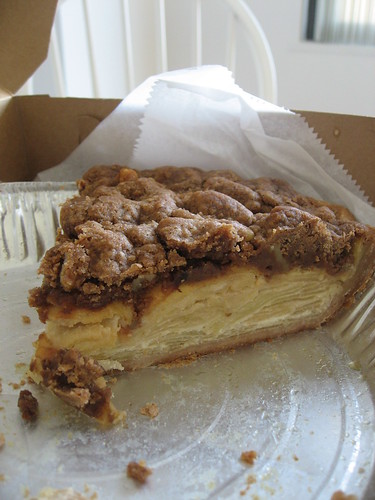
Lest you think this a matter of personal taste, Exhibit A: two additional friends also in town for the weekend, skeptical of my profused love for this pie, but willing to indulge me in the partaking of my birthday deliciousness. Sam requested a small slice, nonchalantly took a bite, and then said, "Wow... this is GOOD." Minutes later, both friends were going back for (larger) seconds.
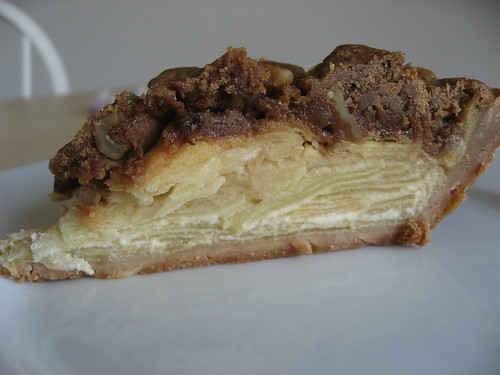
Okay, I said I couldn't fully express how much I love this pie, but I'll try to be more specific beyond just telling you that it's GOOD. There's no mass of syrupy sweet pie goo drowning everything else. The thinly sliced apples (way preferable to big hunks IMHO) are still firm with a little bite, not mushy like some overripe apple that's been sitting on your counter for too long. I have no idea where the sour cream comes in, but if that's what makes this pie so amazing, then I'm not questioning it. I'm not one to generally like nuts in my baked goods either, but if the absence of walnuts changed this pie in any way, I would have none of it.
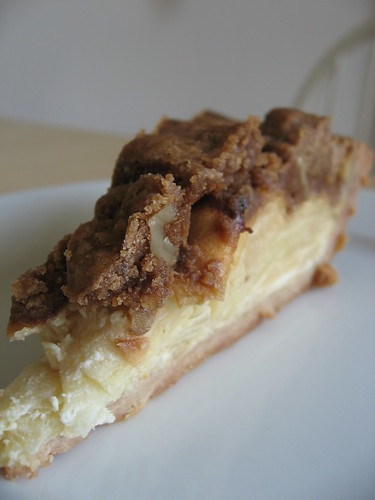
Which brings me back to my last post, and the "most unloved" foods. Note that neither apples nor pie appear on the list (nor sour cream nor walnuts for that matter). Clearly, then, if any country was looking for a specific food to be its cultural ambassador to the world this would be it. I think adopting this pie as THE pie as in, "As American as apple pie" could even do wonders for internal patriotism. As it is, I'm sometimes skeptical of being labeled, "American" and its attendant connotations, but if someone ever likened me to the Little Pie Company's Sour Cream Apple Walnut Pie, I'd say, "Heck yes, with an oven and a fork at the ready!"
*Disregard the brick-like quality of the pie in these pictures; unfortunately the heated version wasn't quite as photogenic. That said, make no mistake: pictures or no pictures, this pie is delicious hot or cold.
Tuesday, May 4, 2010
Food diplomacists beware: The 10 Most Unloved Foods
A friend forwarded this to me the other day... perhaps something to keep in mind for governments trying to woo foreigners with their food: avoid these!*
The 10 Most Unloved Foods
*I, of course, happen to love almost half of the items on the list, maybe because I root for the underdog...
The 10 Most Unloved Foods
*I, of course, happen to love almost half of the items on the list, maybe because I root for the underdog...
Friday, April 23, 2010
BBQ Diplomacy?
I can't decide if I'm further intrigued about this as a case of food diplomacy, or if Reuters just used the catchy title to hook us into what is ultimately a story about one guy's friendship with North Korean diplomats.
Restaurateur wages BBQ diplomacy with N. Korea
I also can't decide if this guy presents an interesting model for citizen diplomacy, or if he just had grandiose visions of being some kind of Cold War-esque spy.
Finally, and I'm only being slightly facetious here, was it the BBQ? And if so, are we talking Texas-style, Carolina mustard, Memphis dry rub, KC Masterpiece, or perhaps some kind of nouveau fashioning (my dad once made some delicious ribs with a blueberry based glaze...)? Or could he just as effectively waged peace with, I don't know... pancakes or pizza or tacos?
Restaurateur wages BBQ diplomacy with N. Korea
I also can't decide if this guy presents an interesting model for citizen diplomacy, or if he just had grandiose visions of being some kind of Cold War-esque spy.
Finally, and I'm only being slightly facetious here, was it the BBQ? And if so, are we talking Texas-style, Carolina mustard, Memphis dry rub, KC Masterpiece, or perhaps some kind of nouveau fashioning (my dad once made some delicious ribs with a blueberry based glaze...)? Or could he just as effectively waged peace with, I don't know... pancakes or pizza or tacos?
Friday, April 16, 2010
Global foodies unite!
Look, another one!
Great Dining Deals in Paris
I'm actually feeling okay about just posting this link without saying much about it because it pretty much captures most of my thoughts on food and the culture of fine dining in itself. I have yet to read any of David Lebovitz's books, but I visit his blog almost every day for the beautiful pictures, witty self-deprecations, and glimpse into the (sweet) life of an American transplant in Paris.
Coincidentally, I also ran across this interview with "celebrity" chef Thomas Keller, in which he asserts that diners across the country (like NYC vs. Napa valley) don't really differ from one another, "because when you're dealing at that high-end level, it's the same type of client. It's the person that appreciates the quality."
Thomas Keller on Running a Culinary Empire
(you may have to register to read the whole interview)
Which all, I think, speaks to a culture of fine dining and haute cuisine specifically, as well as a culture of foodie-ism more generally, that transcends geographical locations and even national cultures. Keller's empire doesn't yet extend outside the United States, and I'd be intrigued to see if his theory about high-end diners might change once it did. But even though national cultures might value food differently, I think he's onto something. Perhaps we can start thinking of foodies around the world as their own diaspora (can you have a diaspora without an originating homeland?), united in the imagined nation-state of deliciousness.
But only if our (imagined) national dish can be the strawberry ice cream with peanut brittle and brownie from Thomas Keller's Ad Hoc, the cookbook for which I, also coincidentally, just received as an early birthday gift yesterday.

*Full disclosure: Thomas Keller has yet to pay me to eat at Ad Hoc, but should he do so one day, I would accept in a heartbeat.
Great Dining Deals in Paris
I'm actually feeling okay about just posting this link without saying much about it because it pretty much captures most of my thoughts on food and the culture of fine dining in itself. I have yet to read any of David Lebovitz's books, but I visit his blog almost every day for the beautiful pictures, witty self-deprecations, and glimpse into the (sweet) life of an American transplant in Paris.
Coincidentally, I also ran across this interview with "celebrity" chef Thomas Keller, in which he asserts that diners across the country (like NYC vs. Napa valley) don't really differ from one another, "because when you're dealing at that high-end level, it's the same type of client. It's the person that appreciates the quality."
Thomas Keller on Running a Culinary Empire
(you may have to register to read the whole interview)
Which all, I think, speaks to a culture of fine dining and haute cuisine specifically, as well as a culture of foodie-ism more generally, that transcends geographical locations and even national cultures. Keller's empire doesn't yet extend outside the United States, and I'd be intrigued to see if his theory about high-end diners might change once it did. But even though national cultures might value food differently, I think he's onto something. Perhaps we can start thinking of foodies around the world as their own diaspora (can you have a diaspora without an originating homeland?), united in the imagined nation-state of deliciousness.
But only if our (imagined) national dish can be the strawberry ice cream with peanut brittle and brownie from Thomas Keller's Ad Hoc, the cookbook for which I, also coincidentally, just received as an early birthday gift yesterday.

*Full disclosure: Thomas Keller has yet to pay me to eat at Ad Hoc, but should he do so one day, I would accept in a heartbeat.
Thursday, April 15, 2010
Know Thyself
When the idea of keeping a blog to track my own explorations of the ways in which food and culture and diplomacy intersect each other (with some identity, branding, and critical analysis thrown in) first germinated in my mind, I knew the biggest challenge was going to be myself. Specifically the part of me that can barely write a one-paragraph e-mail without rewriting each sentence 5+ times, without stopping after a few words to reread the whole thing to make sure the tone and flow are what I want it to be, without typing, then deleting, then retyping the same word several times before finally deciding that that is indeed the word I want to use. You know the idea of "dashing off" an e-mail or a blog post or even a quick text message? Yeah, doesn't happen with me.*
Add to that my desire to live up to the great writing, analysis, and wit of some of my favorite blogs, as well as the intense intimidation of knowing that at least a few of my colleagues who, with the same amount (if not more) of work and commitments and social lives, make this whole blogging thing look incredibly easy are, indeed, reading my blog, and perhaps you can sympathize with the psychological barriers that prevent me from actually, well... blogging.
That said, I also hate to fall into the "starts a blog, posts somewhat regularly for a few weeks, and then falls off the face of the earth" camp. So, here is my compromise: in an attempt to at least keep this blog train going at some sort of speed, I'm going to resign myself to only posting links from time to time, without the full-blown analysis that I would love to accompany said links. I'm still hoping, of course, that some analysis and original thoughts and ruminations can accompany these things from time to time, but if I spread some of these things and leave it up to you to come to your own conclusions (which I'm sure will be brilliant with or without my accompanying commentary), at least I don't have to sacrifice entirely the notion of blogging -- which I still aspire to embody in the full sense of the term at some point in the future.
With that, I would be incredibly remiss not to at least repost this recent blog by Paul Rockower on South Korea's missed opportunity in harnessing the power of the Kogi Taco Truck to further its gastrodiplomacy aims. (And thanks for following me now, Paul!). It would seem that something about LA is particularly conducive to these types of culinary fusions of cultures. The LA Times recently did a piece on the multitude of cultural appropriations of "pizza" on offer in the city of Angels, and while these specimens hardly come close to meeting DOC requirements**, my tastebuds aren't about to quibble with "authenticity". (For Paul's more timely assessment of these offerings, see here).
*Actually, it does happen sometimes, but it often involves me having to talk aloud as I write. Somehow saying things aloud curbs the revisionist in me...
**Link leads to my fave pizza place in DC, which offers both DOC and and non-DOC pizzas, both of which are crazy delicious.
Add to that my desire to live up to the great writing, analysis, and wit of some of my favorite blogs, as well as the intense intimidation of knowing that at least a few of my colleagues who, with the same amount (if not more) of work and commitments and social lives, make this whole blogging thing look incredibly easy are, indeed, reading my blog, and perhaps you can sympathize with the psychological barriers that prevent me from actually, well... blogging.
That said, I also hate to fall into the "starts a blog, posts somewhat regularly for a few weeks, and then falls off the face of the earth" camp. So, here is my compromise: in an attempt to at least keep this blog train going at some sort of speed, I'm going to resign myself to only posting links from time to time, without the full-blown analysis that I would love to accompany said links. I'm still hoping, of course, that some analysis and original thoughts and ruminations can accompany these things from time to time, but if I spread some of these things and leave it up to you to come to your own conclusions (which I'm sure will be brilliant with or without my accompanying commentary), at least I don't have to sacrifice entirely the notion of blogging -- which I still aspire to embody in the full sense of the term at some point in the future.
With that, I would be incredibly remiss not to at least repost this recent blog by Paul Rockower on South Korea's missed opportunity in harnessing the power of the Kogi Taco Truck to further its gastrodiplomacy aims. (And thanks for following me now, Paul!). It would seem that something about LA is particularly conducive to these types of culinary fusions of cultures. The LA Times recently did a piece on the multitude of cultural appropriations of "pizza" on offer in the city of Angels, and while these specimens hardly come close to meeting DOC requirements**, my tastebuds aren't about to quibble with "authenticity". (For Paul's more timely assessment of these offerings, see here).
*Actually, it does happen sometimes, but it often involves me having to talk aloud as I write. Somehow saying things aloud curbs the revisionist in me...
**Link leads to my fave pizza place in DC, which offers both DOC and and non-DOC pizzas, both of which are crazy delicious.
Wednesday, March 31, 2010
Fast food
We all know that fast food culture is steadily spreading throughout the world, often to the detriment of native food cultures. While I’m definitely not on the side of replacing or eliminating native food cultures, I’m not wholly against international fast food expansion per se. In much the same way that processed and ready-made foods can offer an accessible introduction into a new food culture, fast food originating in a foreign culture provides a way of expanding people’s food horizons and palates. It’s also interesting to see how different companies have adapted (or not) to the local cultural context and, on a nerdier level, consider the authenticity and terroir implications of such decisions. For instance, does glocalization on the fast food level constitute a type of fusion cuisine?
Here’s a quick look at some recent strategies to overcome cultural barriers in the fast food expansion industry:
Taco Bell recently opened its first store in India with an adapted menu that is beefless and incorporates more vegetarian options.
Novelty Proves a Hit for Taco Bell in India
Though McDonalds is also known for incorporating local flavors and food patterns into its menus, they found success in Australia by integrating the popular cafe culture into its physical location designs.
McDonald’s Down Under
By contrast, Subway has been expanding WITHOUT glocalizing its menu. After a period of letting individual stores have more control over its offerings, they decided it was more fruitful to maintain central control over the global brand of Subway.
How Subway Went Global
Here’s a quick look at some recent strategies to overcome cultural barriers in the fast food expansion industry:
Taco Bell recently opened its first store in India with an adapted menu that is beefless and incorporates more vegetarian options.
Novelty Proves a Hit for Taco Bell in India
Though McDonalds is also known for incorporating local flavors and food patterns into its menus, they found success in Australia by integrating the popular cafe culture into its physical location designs.
McDonald’s Down Under
By contrast, Subway has been expanding WITHOUT glocalizing its menu. After a period of letting individual stores have more control over its offerings, they decided it was more fruitful to maintain central control over the global brand of Subway.
How Subway Went Global
Friday, March 19, 2010
Crêpe complète

Crêpe complète at Crêperie Bretonne, 67 rue de Charonne, Paris 75011
I suppose I could write about the cultural history of Brittany, and the development of the buckwheat crêpe, or galette. I could distinguish between buckwheat savory crêpes and the more common sweet crêpes, or explore the differences between Japanese crêpes and French crêpes. But all I really want to do is post this picture of a delicious crêpe complète I recently consumed at Crêperie Bretonne in Paris.* This tiny restaurant is an ode to Brittany (and ripe for analysis of cultural representation and tourism what with its huge maps and posters and assorted kitsch adorning every inch of wall space), and the older gentleman who prepared my crêpe looked like he could have walked off the fishing boat five minutes ago. Sadly (for this blog, not for my stomach) my dessert crêpe with confiture de lait (akin to dulce de leche) was out of this world, though less photogenic. You'll just have to visit for yourself to know what I mean.
*Thanks to David Lebovitz for the recommendation.
Tuesday, March 16, 2010
High-fructose corn syrup is okay if it's "ethnic"?
A recent trip to a neighborhood Japanese market got me thinking about how culture affects our perceptions of food. Specifically how, for a certain group of foodies, the idea of "culture" perhaps inspires us to eat or justify eating foods we wouldn't ordinarily consume.
For instance, I generally try to avoid buying and eating processed foods, i.e. most things that come in a box at the supermarket. Since reading The Omnivore's Dilemma, I've also been trying to avoid high fructose corn syrup, more to protest the crazy agricultural policies that allow it to be a cheap "filler" ingredient in lots of food products (do we really need HCFS in our sliced bread?) than the admittedly contested claims to it being less healthy and contributing to obesity rates more than other sugars. Yet, what did I end up buying at the Japanese grocery store? Fried fish cakes (processed fish, sorbitol, MSG, tons of things I can't pronounce), instant yakisoba (MSG), and instant Japanese curry (because, you know, it's so hard to find potatoes and carrots in DC...).
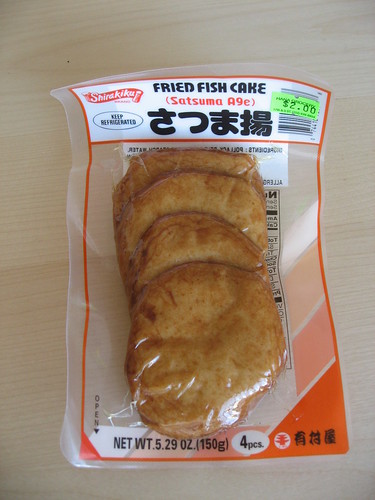
And it's not just Japanese food. I've found myself doing the same thing in foreign supermarkets of every variety. Potato chips rarely earn a second glance from me during my meanderings through Safeway. At Tesco in Britain, though, suddenly Thai curry and ketchup and lemongrass make artificially-flavored crisps more palatable. Instant tapioca tea in Chinese markets, boxed chestnut soup in France, and frozen minced pies in London have all tempted me at one point or another.
It seems I'm trying to eschew American fast/ready-made food culture, only to turn around and buy into its "fill in X culture here" counterparts. Clearly part of the attraction is the novelty factor of either seeing somewhat familiar foods in unexpected forms -- whoa, you can make Thai curry into a potato chip?!? -- or unfamiliar foods in familiar forms, as with instant tapioca tea in the same packaging as instant hot chocolate. By extension, it would seem that these supermarket versions of traditional food cultures might then present an easily accessible introduction into unfamiliar food territory. But how, then to balance cosmopolitan tastes with locavore philosophies? Does interest in foreign foods expressed through the more accessible processed food route undermine attempts to preserve traditional food cultures? Or does it help preserve it by maintaining interest in a more accessible form?
For instance, I generally try to avoid buying and eating processed foods, i.e. most things that come in a box at the supermarket. Since reading The Omnivore's Dilemma, I've also been trying to avoid high fructose corn syrup, more to protest the crazy agricultural policies that allow it to be a cheap "filler" ingredient in lots of food products (do we really need HCFS in our sliced bread?) than the admittedly contested claims to it being less healthy and contributing to obesity rates more than other sugars. Yet, what did I end up buying at the Japanese grocery store? Fried fish cakes (processed fish, sorbitol, MSG, tons of things I can't pronounce), instant yakisoba (MSG), and instant Japanese curry (because, you know, it's so hard to find potatoes and carrots in DC...).

And it's not just Japanese food. I've found myself doing the same thing in foreign supermarkets of every variety. Potato chips rarely earn a second glance from me during my meanderings through Safeway. At Tesco in Britain, though, suddenly Thai curry and ketchup and lemongrass make artificially-flavored crisps more palatable. Instant tapioca tea in Chinese markets, boxed chestnut soup in France, and frozen minced pies in London have all tempted me at one point or another.
It seems I'm trying to eschew American fast/ready-made food culture, only to turn around and buy into its "fill in X culture here" counterparts. Clearly part of the attraction is the novelty factor of either seeing somewhat familiar foods in unexpected forms -- whoa, you can make Thai curry into a potato chip?!? -- or unfamiliar foods in familiar forms, as with instant tapioca tea in the same packaging as instant hot chocolate. By extension, it would seem that these supermarket versions of traditional food cultures might then present an easily accessible introduction into unfamiliar food territory. But how, then to balance cosmopolitan tastes with locavore philosophies? Does interest in foreign foods expressed through the more accessible processed food route undermine attempts to preserve traditional food cultures? Or does it help preserve it by maintaining interest in a more accessible form?
Subscribe to:
Posts (Atom)